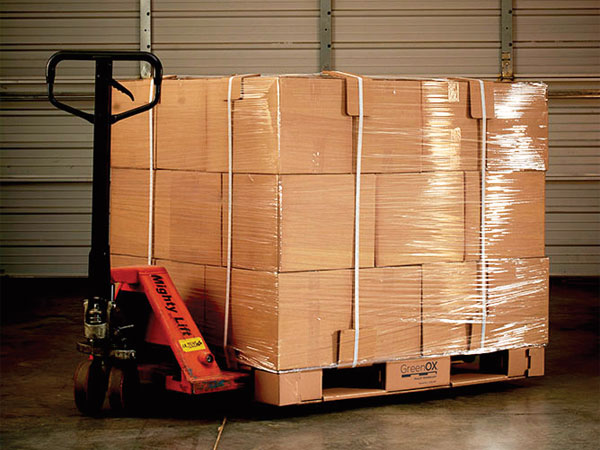The wooden pallet has created a reverse logistics sinkhole of enormous proportions. Pallets clog supermarket lots, warehouse docks and manufacturing floors. Tens of millions of trucks each year are employed to transport pallets back to distribution centers, recycling operations or landfill. Easily damaged, wooden pallets require even more transport and resources for repair and replacement, then back again to the warehouse or manufacturing plant.
Corrugated cardboard pallets, by contrast, offer an environmentally preferable way of storing, stacking and transporting goods, not to mention saving trees. With proven technology, they’re sufficiently strong enough to carry most loads. They’re far lighter and more easily customizable, saving transport costs and expanding truck loads. Because they’re cardboard, they can be efficiently and profitably recycled. There’s nothing to ship back.

The wooden pallet continues to reign supreme. It demonstrates how products that satisfy old, set ways, with established, universal standards, can often trump superior technology, environmental responsibility and even long-term economic benefit.
“The number one factor is inertia,” said Perry. “People are resistant to change.”
This resistance drives cardboard pallet advocates absolutely crazy. “Why aren’t other companies doing this?” asked Adam Pener, president of Green Ox PalletTechnology. Headquartered outside Denver, Green Ox designs and develops corrugated pallets, and has been in the market since 2015. “It’s a fair question and I’m going to go to my grave without knowing the answer.”
Because it’s lighter and customizable, the cardboard pallet saves on trucking costs when goods are shipped. But it also saves by eliminating the need to ship back the pallets. “What IKEA did that I think people really didn’t understand is that they eliminated reverse logistics altogether,” said Pener. For other companies, he continued, “there’s massive leakage, both environmental and financial, that the system creates and it’s all around reverse logistics.”
Walmart, for example, ships around 50 million pallets to its stores each year, said Pener. To get those pallets back requires 125,000 truckloads. What’s more, each pallet must be examined for breakage and 30% must be removed offsite for repair or disposal, another waste of time and energy.
The basic technology for a corrugated cardboard pallet has been around for almost three decades; General Motors began to require suppliers to use cardboard pallets in 1991, a program that lasted until 2010. FedEx now offers cardboard pallets. Cardboard pallet designers and manufacturers are honing the process, making the pallets stronger, more flexible and better able to handle both standard-sized and odd-sized goods. Suppliers include such large paper manufacturers as DS Smith Paper and Conitex Sonoco.
There are issues. Cardboard pallets can’t simply replace wood pallets without modifications to existing infrastructure. Most problematic, wooden pallets are now used in warehouses as shelves in open racks. To accommodate cardboard pallets, the racks must have support, basically cross bars added at the base.
In order to minimize damage to cardboard pallets, forklift drivers and other warehouse workers must be retrained. Some cardboard pallets don’t hold up well with either heavy loads, or adverse weather, making sea travel, for example, a tough slog. Cardboard pallets aren’t well suited for storing goods outside in inclement weather.
Logistics has come to depend on pallets, which were developed in the 1920s. In the US, at least, the pallet is standardized around the GMA pallet, which is 48 inches by 40 inches. Trucks, warehouses, shelves, forklifts, they’re all incumbent on these pieces of wood. “Everything is built around the functionality of this specific design,” said Perry.
The size of the modern-day pallet industry is staggering. The global demand for wooden pallets eclipsed 5 billion in 2017, according to the research group Statista. In the US that year, suppliers added a bit more than 500 million new wooden pallets, with a value of about $8 billion. To meet that demand, wooden pallet manufacturers consumed between 4.1 and 5 million board feet, according to various research data, including that produced by the industry association, the National Wooden Pallet and Container Association. This lumber represented 43% of hardwood and 15% of softwood consumed in the US that year.
Ikea replaced 17 million wood pallets with an equal number of corrugated cardboard pallets. After the Ikea announcement, cardboard pallets manufacturers and environmental advocates fully expected other major companies to follow the lead of the Swedish retailer. That didn’t happen. So now, one focus is on college campuses. Change the Pallet convinced 15 colleges and universities to request their suppliers to ship on cardboard pallets.
Cardboard pallets advocates maintain the faith that eventually, manufacturers will start to use the product, after which the floodgates will open.
“There is a very significant tipping point coming to the market and people are going to get caught flat footed for sure,” predicted Pener. “I just don’t know and I don’t think anyone knows whether the first major movement is going to occur in 2019 or 2020 or 2025 or 2030.”




